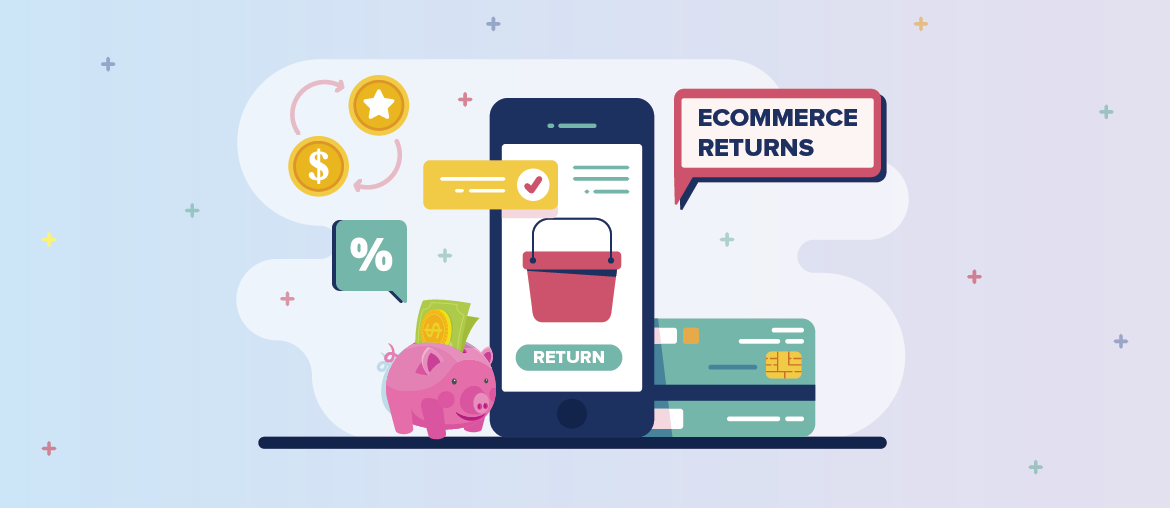Table of contents
eCommerce returns seem like a nightmare to any online retailer, as it leads to undesirable workload, incurs inconvenient hidden costs, and adversely affects product margin. While product returns have gradually become a new normal in the age of online shopping, it’s essential to understand that returns can’t be avoided completely. In fact, the way you prepare for eCommerce return, before and after purchase, can make a difference and help your brand stand out. In this article, we will look at the latest eCommerce return rate statistics and discover the best practices to help product returns become your competitive edge.
eCommerce returns latest statistics and trends
1. eCommerce return rate statistics
- In 2021, online purchase returns spaned in almost all major product categories, ranging from 8% to 88%. Clothing retailers experience eCommerce returns the most, as this is the sector that 88% of consumers had decided to return their order. [1]
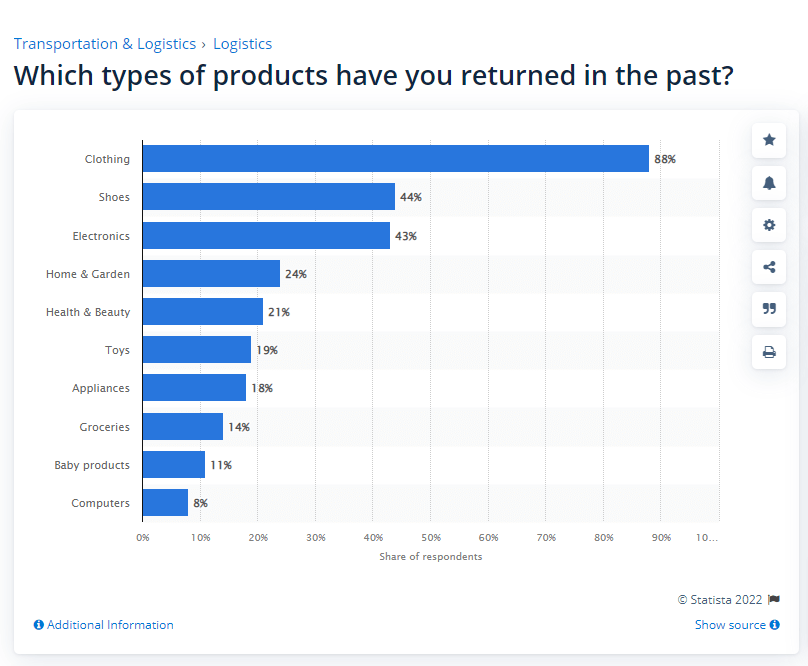
- The payment method that most customers who return their online order use are credit cards (22.78%). [2]
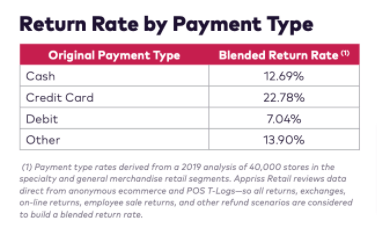
- The National Returns Day 2021, which often occurs at the beginning of January, has morphed into National Returns Week due to the massively increasing number of returns. UPS anticipated that there was a record-setting total of 8.75 million return packages during the week of Jan 4, 2021, 23% increase compared to the 2019-2020 holiday season. [3]
- CBRE projected that eCommerce returns in the US could total $66.7 billion in the 2021 holiday season, which is a 45.6% increase rate compared to 2016. [4]
- Only 17% of retailers have applied AI technology to support their supply chain management and returns. [5]
- Half of the companies in North America and Europe already offered free returns and planned to continue doing so in 2021. [6]
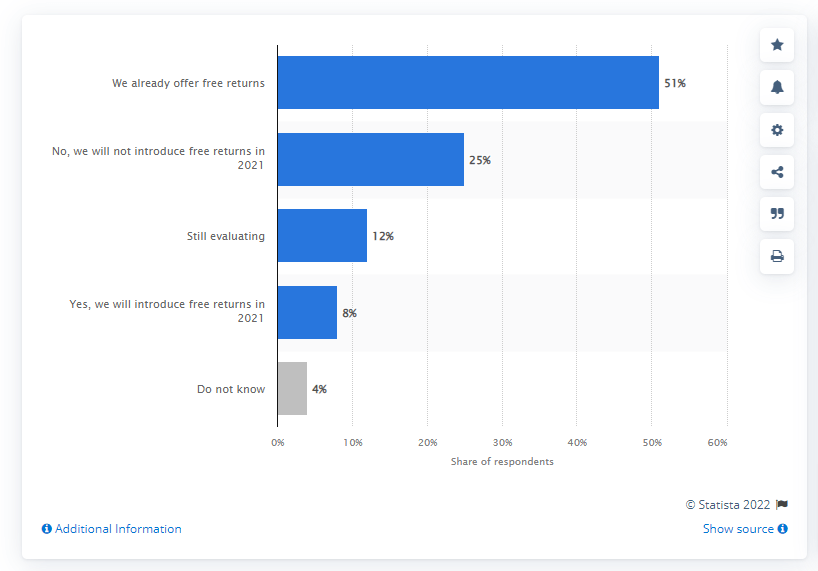
2. Online consumer returns habit
- One of the decisive reasons encouraging people to shop online is the easy returning policy (33%). Other factors that can be mentioned are free delivery and discounts. [7]
- 80% of online customers believe a bad return experience can break their loyalty. [8]
- 57% of shoppers prefer an online shopping experience that provides simple and reliable returns. [9]
- 30% of online customers think fast refunds will contribute to a pleasant returns experience. [10]
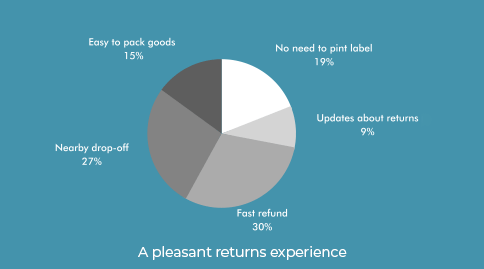
- 55% of respondents made online purchases knowing they were likely to return some of the items purchased. [11]
- 63% of customers expect the return window up to 30 days, while 23% expect the traditional minimum of 14 days. [12]

- 3 out of 4 shoppers in the recent study by Cycleon believe that they could wait for refunds longer if this was done in an environmentally friendly manner. [13]
- 49% of online consumers will check the return policy before deciding to order something. [14]
- 76% of first-time customers who enjoy an easy return experience say they would shop with that retailer again. [15]
- 57% of gen Z consumers believed they will return some of their gifts in the 2021 holiday season. [16]
- Despite being offered free shipping, 44% of consumers still prefer to return in-store. [17]
3. eCommerce returns and Covid-19
- Before Covid-19, around 84% of consumers said they rarely or occasionally returned online purchases. This situation has changed significantly since 2020, as around a quarter of consumers returned between 5% and 15% of what they bought online. [18]

- The return rates in the US could increase to as high as 30% amid the Covid-19 outbreak. [19]
- There are some considerable gaps in the customer return journey pre and after Covid-19. While the average time for customers to register a return and drop off the item was around 7 days pre-Covid, this journey was extended to nearly 12 days after the pandemic happened. [20]
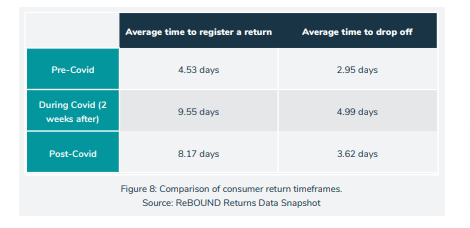
- During the Covid-19, the majority of consumers worldwide prefer non-contact ways to return their orders, such as drop-off (39%) and pick-up (31%). [21]
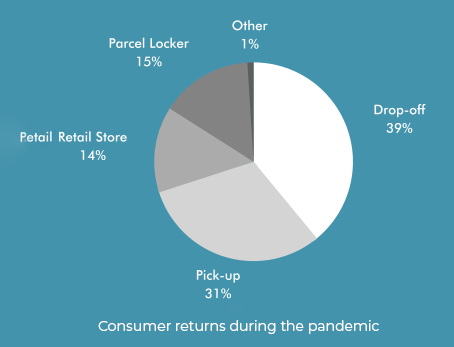
- 42% of consumers had a negative returns experience during the lockdown that they decided to never shop with that retailer again. [22]
- 23% of product returns happen due to inaccurate depictions of the product. [23]
eCommerce returns management
1. What is eCommerce return process?
eCommerce return process concerns working with customers who want to return an item, and then collecting, organizing, and restocking the returned or exchanged items.
A common online return process often involves 5 steps:
- The return process starts when customers receive an order and realize they are not happy with their products. They request a return and/or refund.
- Your staff will decide whether the return request is eligible with the company’s return policy.
- Return product will be picked up by third-party logistics partners/your in-house shipping team, or customers will ship items back to your warehouse
- The product returns to your warehouse or inventory center
- Returned product will be added to the inventory count and ready to be sold if it’s still in good condition.
The return process often involves customer support, logistics, and inventory management, so it is quite complicated and requires a lot of labor force. Therefore, the eCommerce return process hidden cost is normally high, which explains why this is a nightmare for any retailer.
2. Return management system
A return management system helps you handle returns and control the returns process with ease. Normally, a return management system can help both you and customers in managing returns with a smooth process. Customers are able to request returns, print prepaid labels, and ship orders themselves without your involvement. Meanwhile, you can track return status and manage inventory when items are back in your warehouse.
As we agree that eCommerce returns are an inevitable part of your online business, you should include a returns management system in progress to manage returns at your store. A smart return process can save both you and your customers a great deal of time and effort. Each eCommerce platform will come with a different return management system. Depending on the platform you are using, you might need to rely on an extension or an app in order to enhance the return management process at your store.
Best practices to handle product returns
Though product returning has gradually become a norm in the eCommerce industry, there are some practices you can apply to handle this uncomfortable situation. These tactics are applied to reduce the number of returns you have to handle and keep down the costs and efforts you have to put in your product returns process.
1. Turn returns into exchanges
The very first practice you could apply when online shoppers have already requested a return is to turn their returns into exchanges. The major difference between returns and exchanges is profitability. When a return happens, you will lose money on the shipping costs and any profit you made with that order needs to be refunded. Meanwhile, an exchange can protect your profit and keep your business’s cash flow positive.
You can offer free shipping only if customers select the exchange option and charge a small shipping fee for the refund option to encourage exchanges.
You can also suggest alternative products for the returned items so that customers can easily select an exchange item. Perhaps they prefer a different size, color, material, or there are other styles that suit them better.
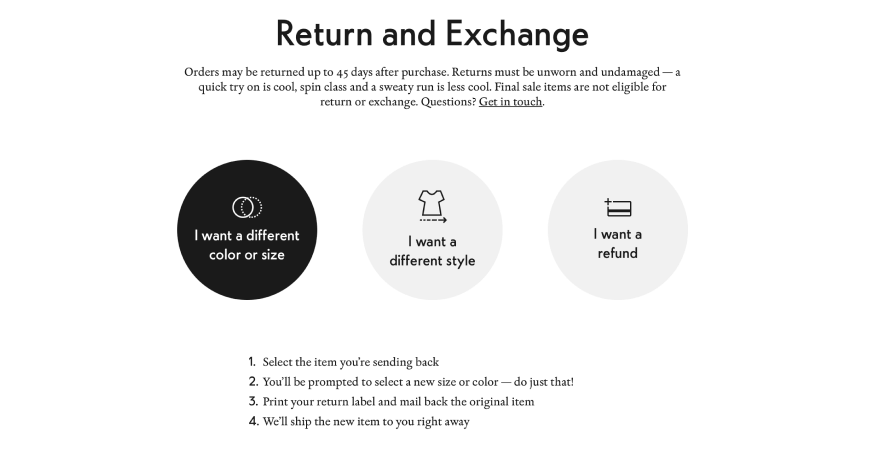
One of the best ways you can apply to encourage exchange is to offer customers coupons and discounts exclusively for this exchange. The incentive gives customers more options to pick an alternative for the item they want to return.
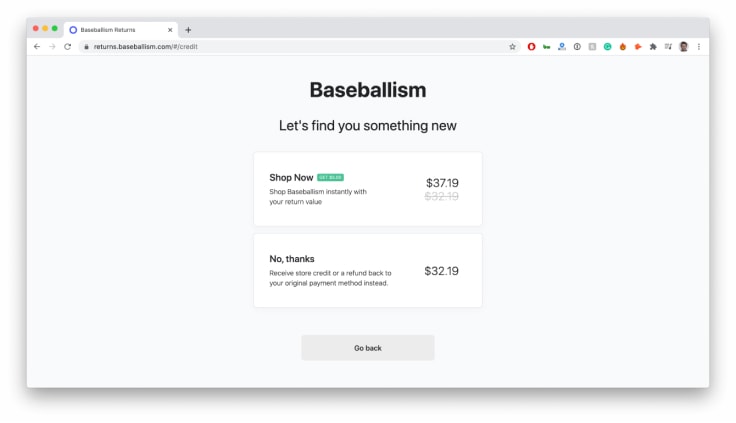
Encouraging exchanges over returns not only reduces your hidden return costs but can also greatly enhance customer lifetime value, as they decided to give you a second chance with the exchange order.
2. Provide clear eCommerce return policy
In order to reduce the number of retail returns from the start, you need to provide a great and clear return policy. A return policy should communicate clearly with your customers about your shipping, return and exchange requirements. While each business may come up with a different return policy due to product condition and logistics, here are some basics that you should cover:
- What items can be returned and/or exchanged
- What items are non-returnable, non-exchangeable
- The timeframe for return and exchange items (5, 10, or 30 days after purchase date)
- In which conditions items will be returned (with tags, original package, original condition, etc.)
- How can customers initiate an exchange or return?
- Who pays the return shipping cost?
Once you have crafted a great return policy, you should display it in strategic places throughout your eCommerce site to make sure shoppers can read it before they decide to make a purchase at your store. Normally, a return policy will be quite long, so you can display a summary of the terms and conditions and link it to the full policy. Some main locations for displaying return policy are:
- Product page
- Checkout page
- FAQ page
- Website chat
- Order confirmation email
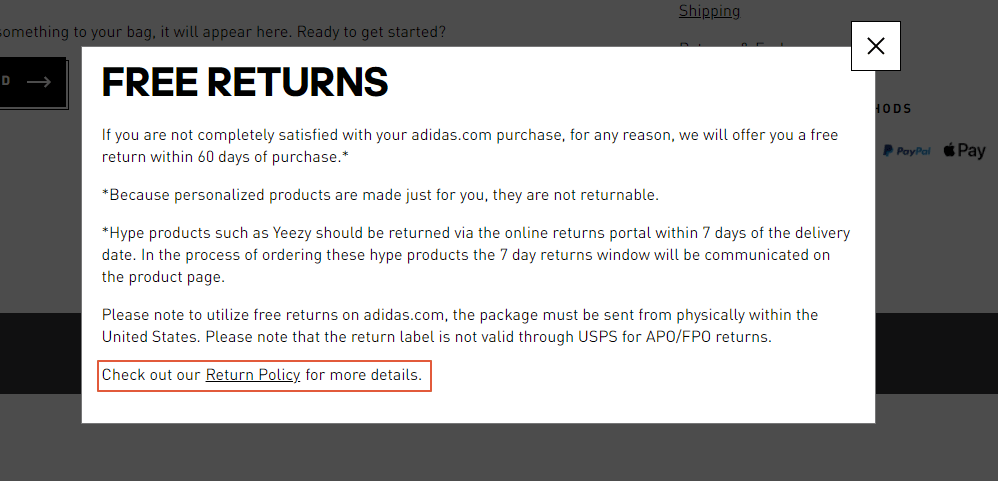
It’s also beneficial to include a return policy at the footer of your site so customers can refer to it whenever necessary. A clear and transparent policy will help you reduce a huge amount of time communicating with customers about return conditions and dealing with unqualified product returns. Besides, potential customers are more likely to buy from brands that offer a clear return policy that can win their trust.
3. Craft accurate and detailed product descriptions
It’s essential that your product descriptions are easy to find, descriptive, and detailed, and your product images need to be as close to your product ỉn reality as possible. If your product description is not clear, or the product arrived is far different from your product images, then there’s a high chance that customers will return this order. Many businesses try to describe the best version of the product to sell as many items as possible, but actually, the hidden cost of product return costs a lot, and they will lose loyal customers if they feel like your product description is unclear about what your products truly are.
In order to reduce returns to a minimum, you should try to include as much information about your product as possible. You can rely on product configurator, such as interactive 3D or augmented reality, to help customers better visualize the product before making a purchase. Normally, your product page needs to include:
- Size guides
- Material information
- Product weight
- Shipping & Return policy
along with pictures of products in different dimensions and videos of products if possible. Once your product description is clear and detailed to help customers get a true sense of your item, your return rate can be reduced significantly.
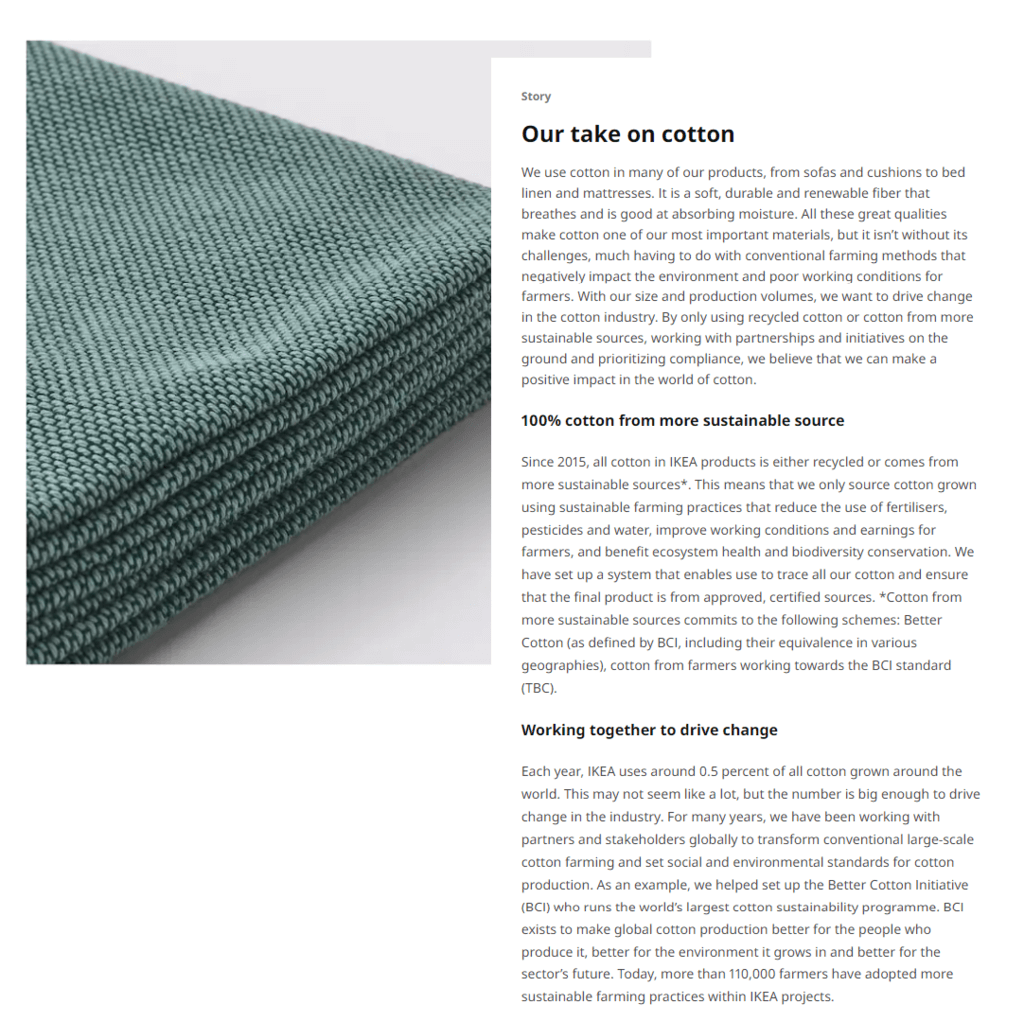
=> Read more: How to Design Your eCommerce Website for Success: A Complete Guide
4. Automate returns process
As we have stated, the returns process or reverse logistics can be quite burdensome and time-consuming with a lot of tasks to fulfill. In fact, the labor costs for handling a return order is far exceeding that of fulfilling an order. The returns process can be easier to handle if you automate some part of the traditional manual process. A return process automation can help you advance the process and reduce the workforce involved in this task.
It’s not possible to automate the whole returns process, but there are some parts that can be automated or made easy:
- Let customers initiate the returns process through a return page.
- Include an automated prepaid label generator for customers to print and label their return orders.
- Utilize an inventory management system (IMS) or order management system (OMS) to manage inventory, returns, and orders across multiple channels better.
=>> Check out: 10 Best Magento 2 Order Management Extensions
- Work with third-party fulfillment during busy and holiday seasons, rather than rely on in-house logistics team only.
5. Keep customers informed about return status
If customers insist on making a return, you need to make sure that they enjoy the easiest return process, as a complicated one can make them lose interest in your brand and you might lose them forever. Besides letting them be well aware of your return policy upfront, it’s also essential that you notify them about return status. You can keep them updated by sending an email or SMS about the return process once they have shipped it.
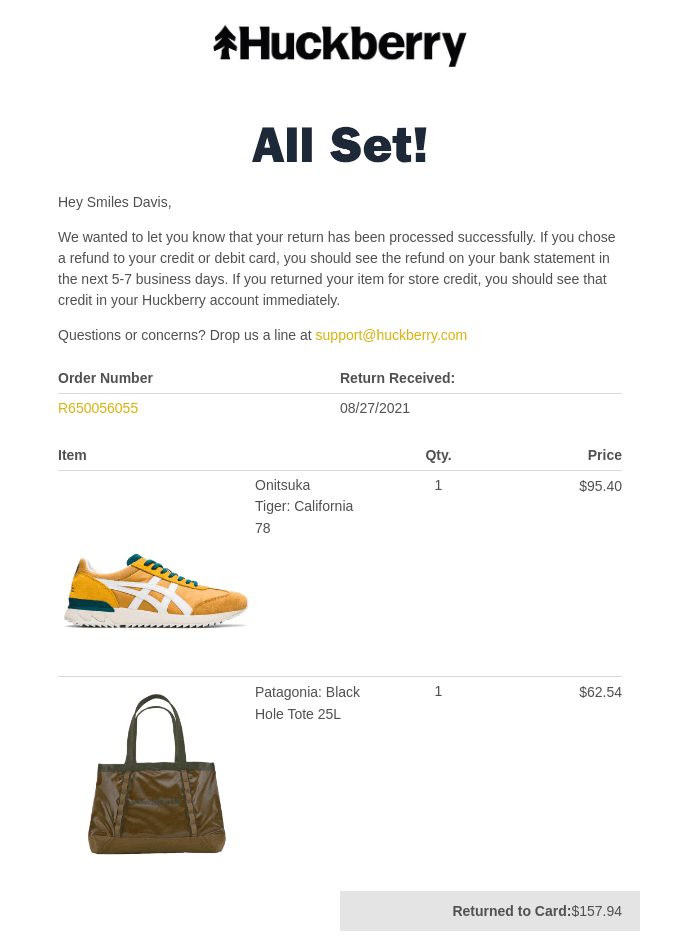
Normally, the shipping carrier will include a tracking number that you can provide to customers so that they can track the shipping status by themselves. Once the returned order arrives, you should send customers an automated email and give them an estimated time on how long they can receive their refund.
6. Make use of analytics and feedback
Asking for further information when customers decide to return the product does not sound important, but this actually can provide insights to help you improve your products and service and reduce the returns rate. Acknowledge why customers are returning items help you identify your issues and try to address them in the future. For example, online shoppers may provide feedback that the product size is not fit, so you know you should provide more detailed size guidelines on your product page.
Besides, getting thorough analytics of products having high return rates could help you to make strategic business decisions, such as improving the products or eliminating them from your store entirely. Reducing retail returns is one step to maximize profits for your eCommerce business, so you should think about it carefully.
Returns can become your opportunity
eCommerce returns is on the rise and it will keep going in this direction when the eCommerce industry is expanding faster than ever. You should prepare for all factors involved in logistics, return, and inventory management in order to handle retail returns and maintain product margin. Not all tactics mentioned above can be practical to your business, but the key thing to remember is that eCommerce returns is not inevitable, but manageable. If you can handle product returns at your store, it might become a golden opportunity to build your brand name and gain loyal customers.

